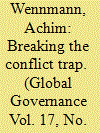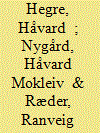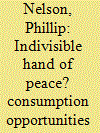| Srl | Item |
| 1 |
ID:
104445


|
|
|
| 2 |
ID:
152301


|
|
|
|
|
| Summary/Abstract |
Several studies show that internal armed conflict breeds conflict by exacerbating conditions that increase the chances of war breaking out again. Empirically, this ‘conflict trap’ works through four pathways: conflicts increase the likelihood of continuation, recurrence, escalation, and diffusion of conflict. Past empirical studies have underestimated the scope and intensity of the conflict trap since they consider the impact of conflict only through one of these pathways and rarely across sufficiently long time periods. This article shows that simulation and forecasting techniques are useful and indeed necessary to quantify the total, aggregated effect of the conflict trap, over long time periods and across countries. We develop a country-year statistical model that allows estimating the probability of no conflict, minor conflict, and major conflict, and the probabilities of transition between these states. A set of variables denoting the immediate and more distant conflict history of the country are used as endogenous predictors in the simulated forecasts. Another set of variables shown to be robustly associated with armed conflict are treated as exogenous predictors. We show that the conflict trap is even more severe than earlier studies have indicated. For instance, if a large low-income country with no previous conflicts is simulated to have two to three years of conflict over the 2015–18 period, we find that it will have nine more years of conflict over the 2019–40 period than if peace holds up to 2018. Conversely, if a large low-income country that has had major conflict with more than 1,000 battle-related deaths in several of the past ten years succeeds in containing violence to minor conflict over the 2015–18 period, we find that it will experience five fewer years of conflict in the subsequent 20 years than if violence continues unabated.
|
|
|
|
|
|
|
|
|
|
|
|
|
|
|
|
| 3 |
ID:
179956


|
|
|
|
|
| Summary/Abstract |
GDP is one of the most robust indicators of civil war onset. As debate continues over the mechanisms underlying the relationship between economic development and civil war, this paper scrutinizes the indicator of GDP directly, disaggregating it into its constituent components to examine whether their distinct associations with conflict onset can shed some light into the black box. Analysis of the individual correlations allows for identification of the driving force behind the aggregate statistical relationship. With this information to hand, consistency checks can be made with existing theories and a new theory presented in this paper, which draws attention to a critical structural factor that drives the supply of civil war labor, namely the lack of consumption opportunities. This factor increases the likelihood of civil war in less economically developed countries as individuals with low consumption opportunities have little to lose from reordering the economic and political system. Analysis of the correlations between components of GDP and the onset of civil war shows that this new theory is most consistent with the key drivers of the aggregate relationship. The examination also highlights a new indicator, which is arguably preferable to GDP as a measure of this relationship.
|
|
|
|
|
|
|
|
|
|
|
|
|
|
|
|